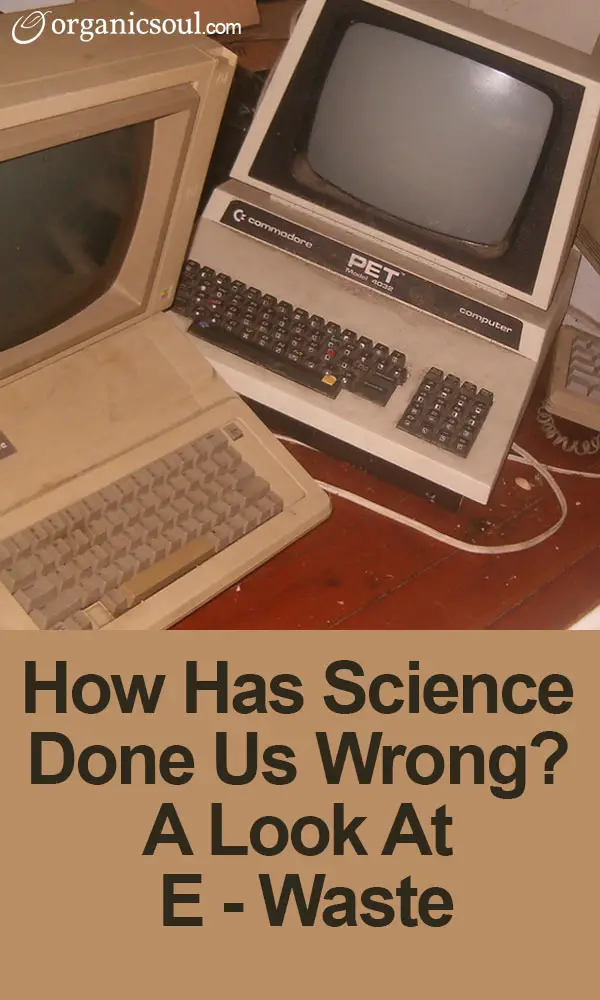Without a doubt, science is the reigning champion of our time. Because of the vast leaps in science, the technological world of today is incomparable to any other point in history. Computers, televisions, copiers, fax machines, and phones have been revolutionized and integrated into the nearly every work environment or household in the US. With this though, there has been an unfortunate growth in electronic discards, known as e-waste, that have devastating environmental effects.
Like Organic Soul on Facebook
While the term “e-waste” has not been clearly defined, it generally refers to consumer or business electronics like those listed above. Some argue, however, that even products like microwaves or similar appliances are grouped into the same category. Personally, e-waste seems to be self-explanatory; it is any type of electronic waste, be it a computer or electronic clock.
What’s the problem with e-waste? Well, there are actually two. First, e-waste pollutes the environment with roughly 40 million tons of both traditional wastes (metals, plastics, etc) and hazardous materials (cathode ray tubes, mercury, lead, and americium). Whether it is incinerated or dumped into a landfill, these toxic chemicals leech there way into the land, atmosphere, and surrounding communities. The subsequent effect is often contaminated water, air, or food supply. Most notably, mercury bio accumulates in the food chain often in fish, a major route of exposure for humans.
Secondly, e-waste is commonly exported to developing countries for illegal and/or unsafe dismantling, often by unprotected workers. Some point the figure at costs for the “need” of exportation; for example, recycling e-waste in North America can cost up to 10 times as much than in developing nations. Thus, in violation of international law and the Basel Convention, countries export e-waste to the Far East, Latin America, India, Africa, and China. While the United States has signed the Basel Convention, it has yet to be ratified, allowing the shipment of 50-80 percent of e-waste to be exported to lesser developed nations. Here in these developing countries, women and children “dismantle” e-waste using little more than stones in search for precious metals like copper, nickel, and gold.
E-waste, then, not only creates both environmental and health safety issues, especially when left to the caprice and corruption of the “informal sector”, but also illegal markets that are unchecked by regulation or government.
Clearly, e-waste has proved itself to be a formidable threat for the world environment, but is there a solution?
Perhaps, yes. Despite the problems generated by e-waste, it has the potential to help stimulate the economies of other countries as well as benefit the companies generating the waste in the first place. All that is needed is a creative business spin.
To U.N. under-secretary general Konrad Osterwalder, “One person's waste can be another's raw material…Smart new technologies and mechanisms, which, combined with national and international policies, can transform waste into assets, creating new businesses with decent green jobs. In the process, countries can help cut pollution linked with mining and manufacturing, and with the disposal of old devices.”
Gold is one of the many profitable materials found in e-waste, and it can be used as an incentive for business. Already there have been efforts to show e-waste's worth, and one instance can be found at the Olympics. Collected from disused circuit boards, the Winter Olympic Games in Vancouver last year used recovered precious metals in trace amounts to help form the champions’ medals.
While the Olympics show a good example of e-waste’s alternative uses, it remains true that the majority of e-waste goes to polluting the air, water, and soil of developing countries. And unfortunately, many signs point to the amount of e-waste doubling in the next 5-10 years, a figure that is even modest to some observers. While this first means a greater exposure to risk to the environment, it also means a greater risk for the women and children working in the waste.
So, about that solution… To better facilitate an environment that is conducive toward proper recycling, infrastructure and technology needs to be developed around the clearly booming market. While state of the art dismantling plants and technology would most likely work better in countries without a large informal market (namely places like Brazil, Colombia, and Morocco), China and India should nevertheless work hands on with informal dismantlers to transition into more environmentally and health minded practices.
booming market. While state of the art dismantling plants and technology would most likely work better in countries without a large informal market (namely places like Brazil, Colombia, and Morocco), China and India should nevertheless work hands on with informal dismantlers to transition into more environmentally and health minded practices.
We should also remember, however, that the e-waste largely begins here, in the United States. We as consumers should always be sure to get rid of e-waste properly. Anyone looking to renovate their home or replace old appliances with eco-friendly products should by aware of how to discard your newly unwanted goods. As a matter of fact, there are hundreds of e-waste facilities across the nation offering no-cost drop off services. For anyone curious, visiting Earth911.com will generate the closest recycling centers near you based on your type of waste.
The solution begins with each of us becoming more aware of how we dispose of e-waste, and what follows should be pressuring your local congressperson or representative to pass environmentally minded legislation.
















